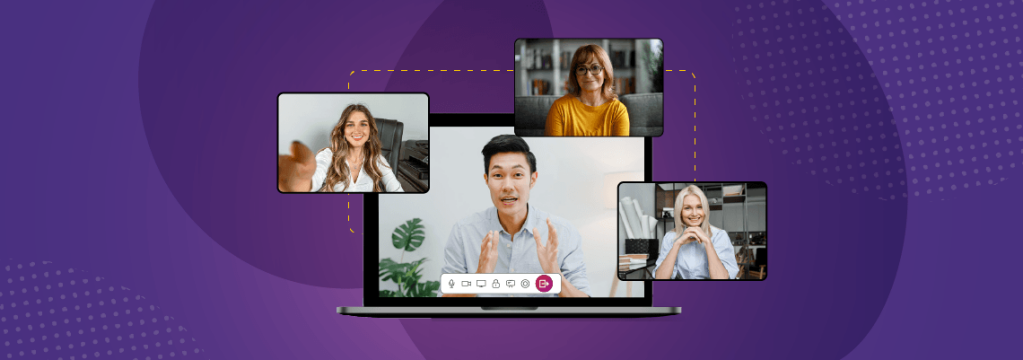Remote video communication has become an essential aspect of modern businesses. However, it’s crucial to understand the differences between building business flows using video API, or simply using video conferencing to bring previously offline functions online. The distinction is important to choose the right tools and workflows for your organization.
In this blog, we’ll delve deeper into the unique aspects of these two types of video communication and discuss the potential drawbacks of using video conferencing tools like Google Meet or Zoom. We’ll also highlight the benefits of using an embedded video API from CPaaS providers that leverages open standards, offers customizable UX elements and additional collaboration features including screenshare, whiteboard & annotations to meet your specific business requirements.
While video, collaboration and chat functions have existed for a while, they have operated as disjointed siloes within a business’s marketing and customer support functions. And while there has been a concerted effort to bring these together, only end to end CPaaS solutions can help bridge all the gaps.
Secondly, when businesses plan digitising existing processes, or creating new ones, the first goal should be to provide a seamless, end to end solutions that delivers customer satisfaction. The logic for such design is simple- in an offline interaction, your representative can manage customer interactions on the fly. In an online setting, the system should work in tandem with your workflows and systems for a seamless customer experience.
The basic premise for choosing a video API provider over a ‘free’ tool is simple: Free video conferencing tools, such as Google Meet or Zoom’s basic version, are often provided as part of larger cloud productivity packages offered by technology giants and offer little to no integration capabilities with 3rd party systems through APIs & SDKs. These providers’ primary focus is on delivering a suite of productivity tools, including email, document management, and collaboration features. As a result, video communication may not always be their top priority, which could lead to limited feature sets, slower updates, and fewer customizations tailored to specific business needs.
In contrast, choosing a dedicated embedded video API designed specifically for video communication ensures that your organization benefits from a product that prioritizes video functionality, offers advanced collaboration features, and provides standard APIs & SDKs for easy integration into solutions and workflows.
Drawbacks of Using Public Video Conferencing Providers
Using public tools like Google Meet or Zoom for remote video support can expose organizations to several issues, including:
- Data Privacy and Security: Such platforms may not be able to meet data localisation and security requirements, especially in highly regulated sectors such as healthcare and financial services
- Low adaptability: Rigid product frameworks as they are designed as end collaboration products
- Broken User Experience: Lack of powerful APIs & SDKs for integration means any time when the customer needs to connect with you, they need to download another app just for the meeting
- Lack of Customization: Public video meeting providers often have limited customization options, restricting businesses from tailoring the user experience to align with their brand identity.
All of these issues are important, one, more than others, should be thought about when choosing video API providers.
Data privacy is a growing concern in today’s digital landscape, and understanding how different platforms and services handle user data is crucial. In the case of communication and collaboration tools like Google Meet and Zoom, customer information, such as email IDs of hosts and participants, is often shared with the service provider. This sharing of personal information can raise privacy concerns for users and organizations alike.
On the other hand, Application Programming Interfaces (APIs) can offer a more privacy-centric approach. APIs allow developers to integrate different software services and functionalities into their applications without directly sharing personal information with the API providers. This can be particularly beneficial for companies looking to create more compliant solutions, as they can minimize data sharing and maintain a greater level of control over user information.
By using APIs, companies can develop their applications in a way that ensures users’ personal data is better protected, while still leveraging the powerful features and capabilities of various software services. This approach can lead to a more secure and privacy-compliant ecosystem.
Benefits of Using an Embedded Video API for Remote Video Support
By choosing an embedded video API, organizations can enjoy numerous advantages, such as:
- Enhanced data privacy and security: An embedded video API adheres to strict security standards and protocols, ensuring your sensitive data remains protected from breaches and unauthorized access.
- Complete customization and tailored user experiences: Unlock the ability to create custom interfaces, workflows, and features that align with your brand and cater to your organization’s specific needs.
- Seamless integration with existing systems: Easily integrate the video API into your current infrastructure, streamlining processes and minimizing disruptions to your operations.
- Complete branding control: Maintain brand consistency by customizing the video solution’s appearance and user experience to match your organization’s identity.
- A feature set designed specifically for remote video support: Gain access to specialized tools and functionalities that enhance the effectiveness of remote support sessions and drive better customer outcomes.
In conclusion, understanding the differences between remote video support and video conferencing is crucial for organizations when selecting communication tools. Public video meeting providers like Google Meet or Zoom may lead to potential liabilities, whereas embedded video APIs offer a more secure, customizable, and scalable solution. By opting for an embedded video API, businesses can deliver top-notch remote video support experiences while mitigating potential risks.
Ready to explore the benefits of an embedded video API for your organization? Schedule a demo to discover the power of our tailored video solutions for remote support.
For more information:


